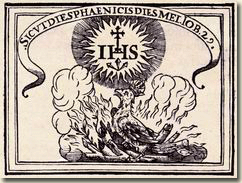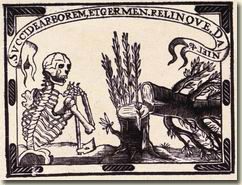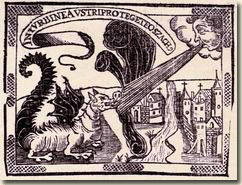|
Society of Jesus,
College of Madrid
Libro de las
honras que hizo el
Colegio de la
Compañía de Jesús de
Madrid a la M. C. de
la Emperatriz doña
María de Austria
fundadora del dicho
Colegio, que se
celebraron a 21 de
abril de 1603.
Madrid: Luis
Sánchez, 1603.
Steven N. Orso, in
Art and Death at
the Spanish Habsburg
Court: The Royal
Exequies for Philip
IV (Columbia,
MO: University of
Missouri Press,
1989), explains in
great detail the
elaborate,
ritualistic
procedures observed
in the Spanish court
of the Austrias to
celebrate royal
exequies in
commemoration of the
death of a monarch.
The catafalque, a
richly adorned small
building, required a
full team for its
design and
construction:
architects, artists
and craftsmen. The
political and
propagandistic
program of the
catafalque,
decorated with
weapons, trophies
and candles, sought
to inspire a
reaction of awed
wonder in the
observer, when
confronted with the
grandeur and majesty
of the deceased. The
catafalque, then,
imposing and
majestic, had to
communicate the
eminence and virtue
of the monarchy, the
earthly incarnation
of divine will, by
means of its grave,
dolorous and
ostentatious
decoration.
Normally, the royal
funereal exequies
would be celebrated
some forty days
after the death of
the individual,
which allowed
sufficient time to
plan and execute a
studied
iconographical
program for which no
expense was spared.
The designers
habitually resorted
to a traditional
repertory of images
and symbols in order
to provoke the
desired reaction of
admiration in the
viewing public. The
form of the
catafalque,
according to Orso,
was usually that of
a baldachin, an
ornamental canopy of
painted wood that
protected the tomb
of the deceased.
The catafalque would
eventually become
the manifestation
par excellence of
ephemeral art in the
sixteenth and
seventeenth
centuries. In order
to reinforce,
perhaps, a moral
lesson of the
transitoriness of
all things human,
the catafalque was
dismantled a few
days after the
exequies, and many
of the decorations
were carried off by
the public as
souvenirs of the
occasion.
The nearly
total disappearance
of an artistic,
political and
cultural artifact of
such importance was
made up for in part
thanks to the custom
of publishing books
with descriptions of
the exequies, books
that sometimes
reproduced in part
or in whole the
visual decoration of
the catafalque and
the tomb.
The anonymous
Libro de las honras
que hizo el Colegio
de la Compañía de
Jesús de Madrid a la
M. C. de la
Emperatriz doña
María de Austria,
fundadora del dicho
Colegio, que se
celebraron a 21 de
abril de 1603
has the honor,
according to Orso,
of being the first
book of its type in
Spain to include
illustrations of the
royal exequies (51).
Later on, the
funereal solemnities
for other queens –
Margarita de Austria
(1612), Isabel de
Borbón (1644), Mª
Luisa de Borbón
(1688) or Mariana de
Austria (1696) –
would enjoy a much
more extensive
expression on the
printed page, with
books that we will
edit in the future
as part of the
planned series of
studiolum.
Nevertheless,
spectacular and
valuable examples of
this genre can
already be accessed
on this CD: we are
referring to the
book signed by Pedro
Rodríguez de
Monforte
(Descripción de las
honras que se
hicieron a la
cathólica magestad
de D. Phelippe
quarto… en el Real
Convento de la
Encarnación,
Madrid, 1666), and
that of Francisco
Antonio de Montalvo
(Noticias
fúnebres de las
reales exequias de
María Luisa de
Borbón… Palermo,
1689).
This Libro de las
honras… in honor
of the patroness of
the Jesuit College
of Madrid, contains
an initial
description of the
decoration of the
church of the
College, followed by
a description of the
catafalque. The book
then reproduces the
text of the funeral
oration in Latin by
father Juan Ludovico
de la Cerda, and the
sermon delivered by
father Jerónimo de
Florencia in which,
by means of a gloss
of the Book of Job,
he emphasizes the
ascetic quality of
Maria de Austria
during the final
stage of her life,
when she withdrew to
the Monastery of the
Descalzas Reales in
Madrid, as well as
her acts of charity
on behalf of the
poor in general, and
also on behalf of
some religious
orders, especially
the Franciscans and
Jesuits.
The rest of the book
consists of the
hieroglyphs that
were invented for
the exequies, with
their corresponding
poems in Hebrew,
Greek, Latin and
Spanish. The
predominant
symbolism in these
hieroglyphs alludes
to the regal power
of the Austrias, and
abounds in eagles,
imperial or regal
crowns, etc., and
other images
appropriate to
Jesuit imagery (IHS
anagram, etc.)
It is
important to point
out the special
taste for this type
of exercise that was
developing so
intensely in the
bosom of the Society
of Jesus, and which
would only grow
stronger in its
Colleges until the
end of the
Seventeenth century.
In this particular
instance we clearly
observe the subtle
use by the College
of the death of its
founder in order to
promote itself and
to establish the
Society as a great
defender of
Catholicism in
Europe.
This book has never
been reedited since
then. On the CD
“Corpus of
Spanish Emblem
Books” we edit the
only edition of this
work.
|
| |
Hieroglyph 12 SICVT DIES PHAENICIS DIES MEI.
Iob 29

Con essos hermosos rayos,
Que rayan en tus cenizas,
Te renueuas y eternizas.
AVnque el Geroglifico de la aue Fenix ha aplicado à muchas personas,
quiza jamas à nadie con la razon que à la Emperatriz Maria, tan
vnica en el mundo, quanto ninguna otra Emperatriz. En lugar del Sol
se pinta el glorioso nombre de IESVS, de cuyos rayos se enamora, y à
cuyo calor se abrasa. Sinificase por ello el grande amor y deuocion
que tuuo esta señora con el nombre de IESVS, y con la Compañia deste
nombre. En lo que toca a la letra de la Escritura, se aduierta, que
la Vulgata lee: Et sicut palma multiplicabo dies meos. Otra
version buelue como aqui se cita, con fundamento, de que la palabra
Griega de los Setenta, φοινιξ sinifica lo vno y lo otro: y lo vno y
lo otro viene conforme al intento del Espiritu santo, que es dar à
entender muchedumbre de años, en los quales, assi la palma, como la
Fenix, excede la vna à todas las aues, la otra à todos los arboles.
Hieroglyph 16
SVCCIDE ARBOREM, ET GERMEN RELINQVE. DANIEL. 4

Hermosos pimpollos dexa,
Donde se conserue, y viua,
El que oy la muerte derriba.
LOs hombres de edad, son comparados à los arboles robustos y viejos,
y ya carcomidos con los largos años: tal pintò Lucano al Capitan
Pompeyo. Viene pues à proposito este mismo arbol, ya caydo, y
derribado, para lo que la muerte hizo en derribar con su golpe à
esta señora: pero quedaron deste arbol pimpollos, con que el de
nueuo se viene à renouar: estos son sus gloriosos hijos y hijas,
cuya memoria es y serà eterna en el mundo, cuya gloria sin par, cuya
grandeza admirable.
Hieroglyph 21 VT
PVPILLAM OCVLI

Queriendo tan fuerte escudo
Tan de veras ampararme,
Ninguno podra tocarme.
PAra declarar el amparo que hizo siempre la Magestad de la
Emperatriz à la Compañia de IESVS, se pintan muchas saetas, que van
encaminadas al nombre de IESVS, pero no llegan à el, porque ésta
señora las recibe primero en su escudo. Quantas murmuraciones, mas
agudas y penetrantes que saetas, quebrò y deshizo con su Imperial
amparo? Quantas vezes se hizo dueño de los agrauios que nos hazian,
satisfaziendo ella por nosotros, y descubriendo al mundo la verdad
con que trata la Compañia? Al fin le parecia que era llegarle à las
niñas de los ojos, todas las vezes que se hazia alguna cosa contra
nosotros.
Hieroglyph 25
IN TVRBINE AVSTRI PROTEGET EOS. ZACH.

Con soplo del Austro viento
Se deshizo l’infeccion,
Que del infernal Dragon
Esparzio el dañado aliento.
NO es otra cosa la heregia, que vn Dragon espantoso, que vomita humo
y fuego, con que inficiona las ciudades, los reynos, y todo el
mundo. Esto sinifica el que estàs mirando, y este es el Dragon, que
ha leuantado en tantas partes el lastimoso incendio que aora
lloramos. Procurò ésta señora apartar en quanto pudo éste anhelito,
y de hecho, mientras viuio, le apartò de muchas partes: para lo qual
se pinta el viento Austro, que con su aliento desparrama el fuego
del Dragon de manera que no vaya à dar en las ciudades. |